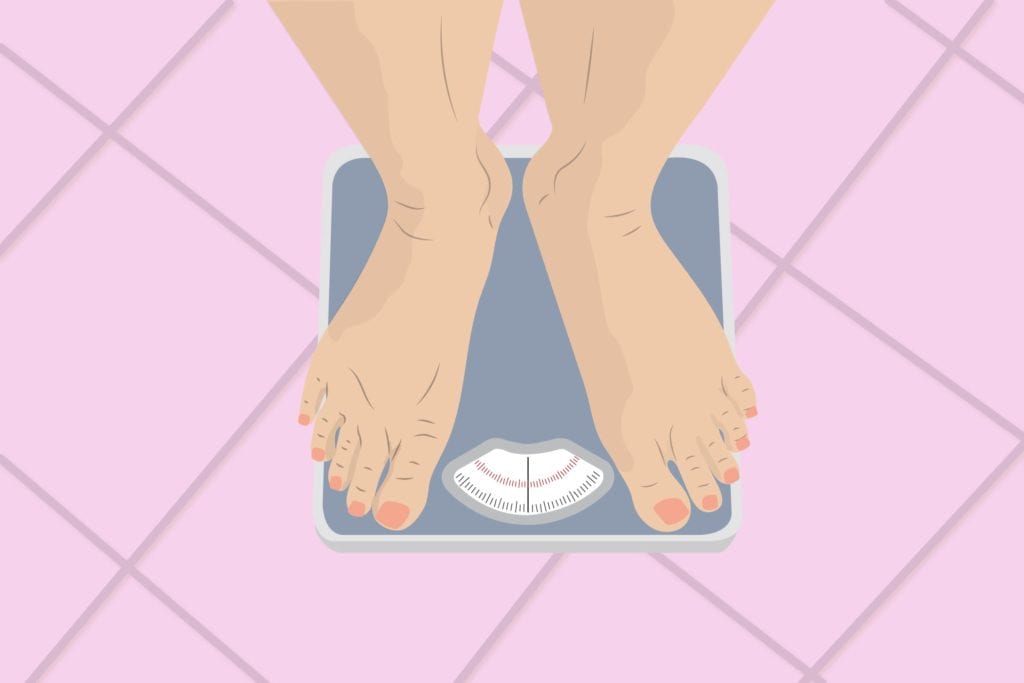“You have a fatty liver.” Well, that stung like a yellow jacket. A new diagnosis is hard enough, but one with fatty in the title felt harsh. The gastrointestinal doctor (GI) explained that with nonalcoholic fatty liver disease (NAFLD), there is excess fat in the liver. My ALT (Alanine Aminotransferase) and AST (Aspartate Aminotransferase) levels were elevated. I felt it coming. He was building up to those two words I didn’t want to hear.
Looking me squarely in the eyes over his face mask, he gave the directive: “Lose weight.”
It’s probably good that he didn’t see my smirk under my face mask. “The biopsy of intestinal tissue we took during your colonoscopy shows you have microscopic colitis,” he added. Two diagnoses in one appointment? Jackpot! I got my co-pay’s worth of new ailments at this visit.
Microscopic colitis is an inflammation of the large intestine that is identified by looking at intestinal tissues through a microscope. The exact cause of my microscopic colitis is not known, but it could be from having autoimmune diseases, my food sensitivities, medications, a virus, or even a combination of those.
This was a lot to unpack. I contacted my rheumatologist about the liver levels because I suspected he might want me to stop my weekly injections of methotrexate (which can be tough on the liver). My rheumatologist advised decreasing my dosage but warned against stopping it entirely.
What We Eat Can Impact Inflammation
My GI doctor suggested I stick to a diet of bland foods like apple sauce, rice, and non-fibrous foods for a while. I had already been eating gluten-free and dairy-free due to my extreme food intolerances, and I tried to stick to anti-inflammatory foods.
I wondered what other dietary changes would now be necessary. The doctor reminded me that just because one is eating a diet without gluten or dairy does not mean it’s necessarily healthy. With all the new gluten-free products available at the grocery store, it can be far too easy to succumb to the gravitational force of the processed foods aisle.
According to the American College of Gastroenterology, the most effective treatment for fatty liver involves “changes in how you eat and live including weight loss, increasing your exercise, eating a balanced diet, and avoiding alcohol.” All of these changes can help with both fatty liver and managing the symptoms of microscopic colitis.
Other foods and beverages I now eat in moderation and avoid during a microscopic colitis flare-up include:
- Those with a high volume of sugar or artificial sweeteners
- Raw fruits and vegetables
- Caffeine
- High-fiber foods like beans and nuts
- Foods that are spicy, fried, or fatty
There are other health benefits to losing weight if you are overweight. People like me with rheumatoid arthritis are 50 percent more likely to develop cardiovascular disease compared to the general population.
Being Proactive About Your Health
It can be scary to think about all the possible complications an autoimmune condition might create. Having already had a scare with pulmonary embolisms several years ago, I knew I needed to be mindful of my symptoms and share them with my rheumatologist and specialty doctors if necessary.
Here are a few ways that I try to stay proactive about my treatment plan to avoid an unwanted trip to the emergency room.
- Stay on schedule with prescribed medications and tell your doctor about side effects if you experience them.
- Exercise in moderation. Too much exertion at once could knock you down for days. Daily low-impact exercises and stretching are easier on the joints and can make an enormous difference in how you feel.
- Talk with your doctor about healthy lifestyle changes. My primary care provider connected me with a free weight-loss coach I hope to meet with soon.
Hard Work Pays Off
I lost weight, and six months later, we checked my liver levels once again. My ALT and AST levels were normal and they’ve stayed normal through today.
There are four key factors that led to shedding the 40 pounds I’ve lost so far. I consulted my primary care doctor, rheumatologist, and gastroenterologist before making these diet and exercise changes.
- I walk at least three miles, four to five days per week.
- I use intermittent fasting, which means I do not eat after 7 pm and resume eating at 10:30 am.
- I follow the FODMAP diet most days to keep inflammation down and avoid flares.
- I try to avoid the aisle of cookies and crackers, but the force is strong with that one.
It’s not going perfectly, but if I deviate from my health plan, I know tomorrow is a new day and I’ll feel better when I get back on track. My personal goal is to lose another 40 pounds, which I had gained when I had to take steroids for a long time.
The pressure to lose weight was intense for me nine months ago when I got the double diagnosis. I knew that I couldn’t possibly be alone in this feeling, so I reached out to friends for support. I’m especially thankful for my family and close buddies for lifting me up and acknowledging my efforts to eat well and exercise regularly.
If you want to lose weight, don’t just blindly pick one of the hundreds of weight-loss plans out there, talk with your doctor about a diet and exercise plan that is right for you, along with any obstacles you are facing and how your current medications may be impacted.
Be a More Proactive Patient with ArthritisPower
ArthritisPower is a patient-led, patient-centered research registry for joint, bone, and inflammatory skin conditions. You can participate in voluntary research studies about your health conditions and use the app to track your symptoms, disease activity, and medications — and share with your doctor. Learn more and sign up here.






